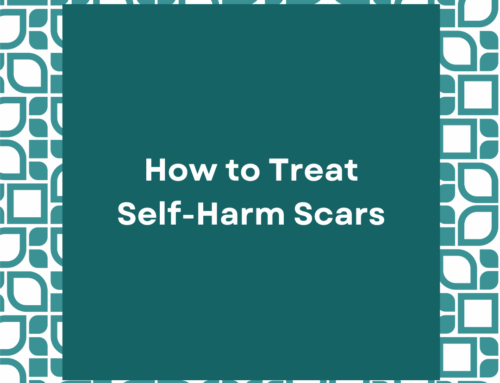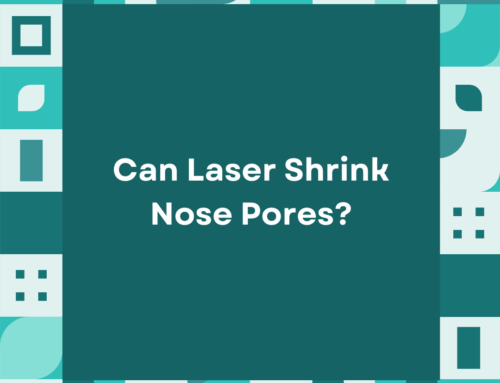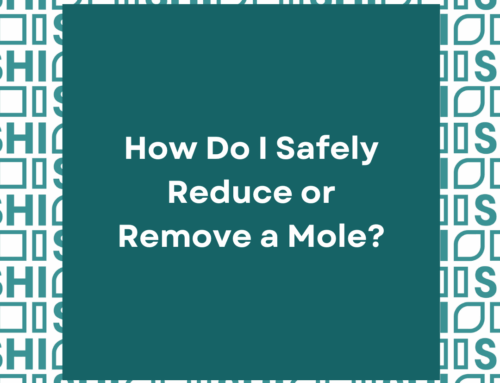CO2 Laser for Acne Scars: Is It a One Size Fits All Treatment?
Short answer: CO₂ laser is not the gold standard treatment for acne scars.
When researching treatments for acne scars, many people come across CO2 laser resurfacing as a widely advertised solution. It’s commonly used in dermatology to improve skin texture, tighten sagging areas, and smooth out superficial imperfections. For issues like fine lines, enlarged pores, and uneven pigmentation, it can be a powerful tool. But when it comes to acne scarring, especially the deep, pitted kind, the picture is far more nuanced.
CO2 laser may be beneficial in select cases, but using it as a catch-all solution for acne scars is often old-fashioned/outdated, misguided, and sometimes harmful/counter productive. At Scar Healing Institute (SHI), we use our cutting edge treatments to heal patients who have already undergone multiple laser sessions with minimal improvement, and sometimes new complications. Why? Because acne scars are structural problems beneath the surface, and CO2 laser, by design, treats superficially and indiscriminately.
This article breaks down what CO2 lasers can and can’t do for acne scars, highlights the risks for certain skin types, and introduces more precise, scar-specific alternatives that deliver superior results with fewer complications.
Introduction to Acne Scarring
Acne scarring is a common condition that can affect people of all ages and backgrounds, often causing significant distress and long-lasting effects on self-esteem. Most scars develop after severe forms of acne, particularly cystic acne, which can damage deeper layers of skin. When inflammation disrupts the healing process, it can leave permanent changes in skin texture and appearance.
The most common form of acne scarring is atrophic scarring, which occurs when inflammation damages the skin and underlying tissues. This process not only breaks down collagen and subcutaneous fat but can also cause layers of tissue to fuse together, creating tethered scars. These tether points pull the skin downward, resulting in visible depressions or pits that are difficult to conceal, as shown in the figure below.
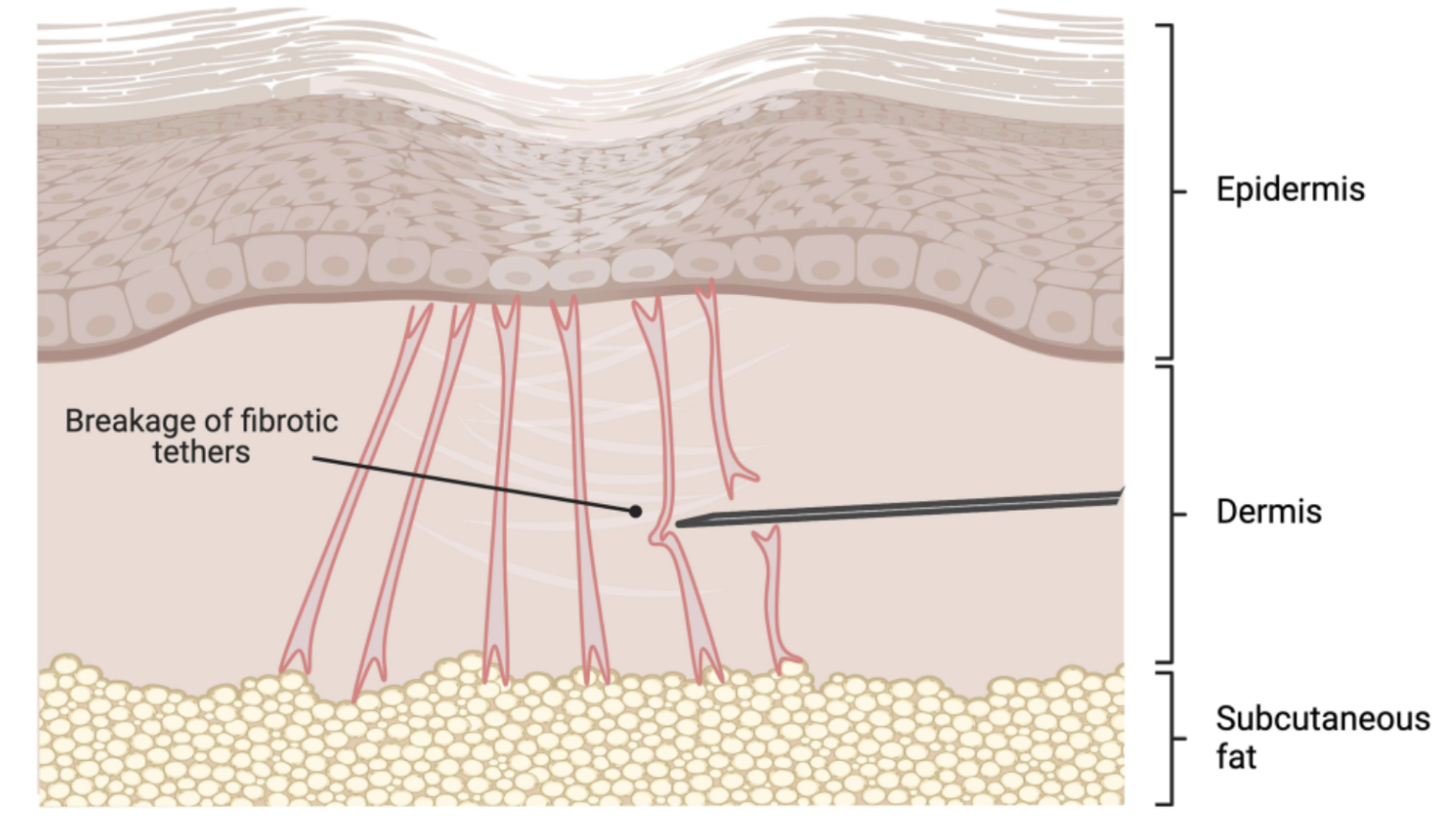
Skin Damage Graphic
Types of Acne Scars
Acne scars come in several distinct forms, each with unique characteristics that influence how they should be treated. The most common are atrophic acne scars, which are further divided into three main types: ice pick scars, boxcar scars, and rolling scars. Ice pick scars (A) are deep, narrow, and often extend into the skin, making them challenging to treat. Boxcar scars (B) are wider with sharply defined edges, giving the skin a pitted look. Rolling scars (C), on the other hand, create a broad, undulating appearance with sloping edges, resulting in a wavy texture across the skin.
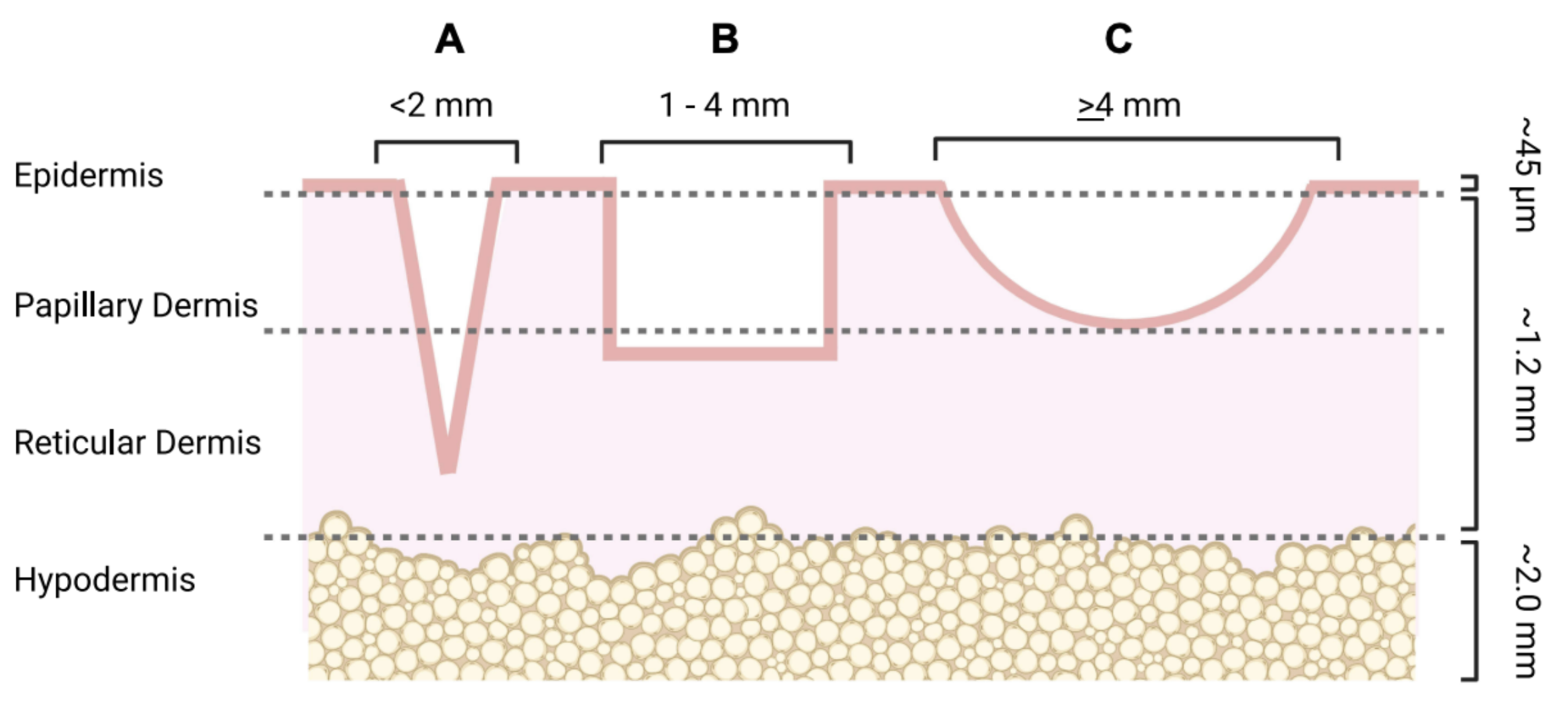
Types of Acne Scars Graphic
In addition to atrophic scars, some individuals develop hypertrophic and keloid scars, which are raised, firm, and can extend beyond the original area of injury. Keloid scars may be itchy, tender, or even painful, and are more common in certain skin types. Hypertrophic scars are also raised but tend to remain within the boundaries of the original acne lesion and are generally smaller than keloids.
Understanding the types of acne scars you have is crucial for developing an effective treatment plan. Each scar type, whether it’s an ice pick, boxcar, rolling, keloid, or hypertrophic scar, responds differently to various treatments. A tailored approach is essential for improving the appearance of acne scars and achieving smoother, healthier-looking skin.
What Is CO2 Laser Resurfacing and What Does It Do Well?
CO2 (carbon dioxide) laser resurfacing is a technique that uses high-energy light to vaporize the outer layers of skin in a controlled way. By removing damaged skin cells, including dead skin cells, and stimulating collagen production, the laser helps to tighten skin, fade age spots, and reduce the appearance of fine lines and textural irregularities.
For skin rejuvenation, CO2 laser is a respected and effective tool. It promotes a smoother, brighter complexion by kickstarting your body’s natural wound-healing response. Over time, this boosts collagen and elastin production, key ingredients in youthful-looking skin. The laser also stimulates the formation of new collagen fibers, which are essential for repairing the skin and improving its texture.
However, as acne scar specialists will attest, any laser or all other energy based treatments, are not recommended as a first line treatments for acne scars. This is because these non discriminatory treatments do not distinguish between healthy and scarred tissue and treat them as if they were though scar tissue, thinning healthy tissue while treating the scars . While it may slightly soften superficial scars or shallow textural issues, it lacks the depth and precision required to effectively treat structural atrophic acne scars like icepick, boxcar, and rolling scars.
Why CO2 Lasers Often Miss the Mark for Acne Scarring
1. Acne Scars Are Deep, Anchored, and Structural
Atrophic acne scars are not surface-level imperfections. They are the result of chronic inflammation and collagen degradation in the deeper dermis. These scars often form in the affected area where tissue and collagen loss has occurred, leading to localized depressions or indentations in the skin. Over time, this leads to depressed or tethered scars that cannot be improved meaningfully by simply smoothing the skin’s surface.
CO2 laser works from the top down, vaporizing layers of the epidermis and upper dermis. But most acne scars begin at the base, where fibrotic bands pull the skin downward or where volume loss has hollowed the tissue. Because lasers cannot reach or release these tethers effectively, they may soften the appearance slightly but rarely produce substantial structural improvement.
Many patients undergo multiple CO2 sessions hoping for significant change, only to find their skin slightly smoother, but the actual scars unchanged.
2. Collateral Damage: CO2 Removes Healthy Tissue
One of the key limitations of CO2 lasers is their non-specificity. The beam does not distinguish between scarred and unscarred tissue, it treats everything in its path. This often results in removal of healthy skin in an effort to “even out” the surface. While this may seem logical on paper, it leads to unnecessary trauma and can even create new issues like hypopigmentation, worsened texture, or uneven skin tone.
In essence, CO2 is a mowing-down technique, flattening the surrounding skin to match the scarred areas, rather than elevating the scar itself. In contrast, more advanced treatment options like subcision or the CROSS technique work within the scar to rebuild from the bottom up while leaving healthy tissue untouched. These treatment options are typically performed in a dermatologist’s office to ensure optimal safety and results.
3. Limited Impact on Tethered Scars
Rolling scars are often held down by fibrous bands tethering the skin to underlying tissue. These bands act like anchors, preventing the scar from rising to the level of the surrounding skin. As a result, rolling scars create a rolling or undulating appearance, leading to an uneven appearance of the skin. CO2 lasers cannot cut or release these tethers, so even if collagen production is stimulated in the surrounding area, the depression remains.
This is why patients with rolling scars often see only modest changes, even after multiple, expensive laser sessions. Without releasing the tether, the structural defect persists.
CO2 Laser Risks—Especially for Skin of Color
Patients with Fitzpatrick skin types IV to VI (medium to darker skin tones) must approach CO₂ laser with extreme caution. The heat and trauma induced by the laser can lead to post-inflammatory hyperpigmentation (PIH), hypopigmentation, or even permanent light spots. Individuals with a history of red bumps or inflamed acne are at higher risk for developing raised scars after laser treatments.
These pigmentary changes can be difficult to reverse and may persist long after the skin heals. In rare cases, the laser can trigger hypertrophic scarring or keloids, especially if the skin barrier is disrupted or the patient is prone to abnormal healing, including the formation of raised scars due to excess collagen production.
Another risk? The unmistakable “laser face” look. CO₂ laser, especially when used aggressively, can leave behind a telltale glazed, almost plastic appearance. This happens when heat vaporizes superficial layers of skin and collapses pores, erasing natural texture and replacing it with an overly smooth, artificial finish. While some may associate this with a “glass skin” aesthetic, in reality, it can signal over-treatment and disruption of the skin’s natural balance.
Not all machines are created equally, and more importantly, not all hands are trained to use them. CO₂ lasers are powerful tools that require a deep understanding of skin anatomy, healing patterns, and how to calibrate intensity appropriately, especially for patients with skin of color.
For these individuals, safer, more targeted interventions that minimize trauma and focus solely on scarred tissue, not the surrounding healthy skin, are strongly preferred.
A Smarter Approach: Precision, Preservation, and Personalization
At SHI, we believe that treating acne scars requires more than a broad-stroke tool like a CO2 laser. We focus on manual, scar-specific treatments that target the root cause of each individual scar while preserving healthy tissue.
This approach is not only more effective, it is safer, especially for diverse skin types. By combining techniques like subcision, CROSS, regenerative injectables, and dermal fillers as additional treatment options, we customize each treatment plan for maximum precision and minimal downtime.
Subcision: Releasing Scars from Below
Subcision is a minimally invasive technique in which a fine needle is used to manually break the fibrous bands that pull rolling scars downward. It addresses one of the fundamental causes of atrophic scars: tethering.
Once released, the skin begins to lift naturally. The resulting wound channel also stimulates new collagen formation, helping the scar fill in over time. While subcision is often compared to CO2 laser for treating rolling scars, for some deeper scars, surgical treatment such as subcision or skin grafting may be considered if less invasive methods are insufficient.
Benefits of Subcision
- Physically detaches the scar from underlying tissue
- Encourages the body to heal from the bottom up
- Preserves surrounding healthy skin
- Can be enhanced with biologics like PRP, PRF, exosomes, Sculptra, or salmon DNA to boost healing and regeneration
Compared to CO2 laser, which flattens from above, subcision restores from beneath, where the scar actually begins.
CROSS Technique: Deep Remodeling for Icepick and Boxcar Scars
The CROSS (Chemical Reconstruction of Skin Scars) technique is used for icepick and narrow boxcar acne scars. A high-concentration acid is applied directly into the scar, triggering deep remodeling and collagen growth. Unlike lasers, CROSS precisely affects only the scar cavity, not the surrounding skin.
At SHI, we’ve refined the traditional CROSS technique by developing a custom acid blend that improves results and minimizes side effects. Our formulation is designed to reduce the risk of scar widening, a known issue with traditional TCA applications.
CROSS Offers
- Controlled and targeted treatment
- Safety across all skin types when performed by trained providers
- True remodeling of deep scar tissue over time
Why Targeted Treatment Wins
Laser treatments often aim for broad resurfacing. But acne scars are not spread uniformly, they vary in depth, shape, and response. That’s why precision is key.
Manual treatments like subcision and CROSS allow providers to tailor the intervention to each scar, rather than subjecting the entire face to trauma. The result is more effective, more natural-looking, and less risky for skin of color.
The Power of Combination Therapy
The best results come from strategic combination treatments tailored to the individual. A comprehensive SHI plan may include:
- Subcision to release tethered rolling scars
- CROSS for icepick and narrow boxcar scars
- Fractional lasers (used selectively for texture or tone)
- Biologic injectables to stimulate collagen and speed healing
- Topicals to reduce inflammation and support recovery
While some individuals may try home remedies for acne scars, these approaches are generally less effective than professional treatments, especially for significant scarring. Every scar is different. A one-size-fits-all tool like CO2 cannot offer the personalization or precision that true scar correction requires.
Prevention and Maintenance
Preventing acne scarring starts with effective acne management and a commitment to healthy skin care habits. Using non-comedogenic products, avoiding the temptation to pick or squeeze acne lesions, and protecting your skin from sun exposure are all essential steps in reducing the risk of developing acne scars. For those who already have acne scars, ongoing maintenance is key to preventing further scarring and preserving the results of any treatments.
Regular visits to a dermatologist can help monitor your skin’s progress and catch any new issues early. Incorporating gentle skincare routines, using sunscreen daily, and following your dermatologist’s recommendations can all help maintain the appearance of your skin and minimize the risk of additional scarring. Early intervention is especially important—treating acne scars as soon as they appear can improve their appearance and prevent them from becoming more pronounced. By understanding the different types of acne scars and taking proactive steps, you can support your skin’s health and work toward a smoother, more even complexion.
Conclusion: Why Precision Beats Power
CO2 laser has a place in dermatology, but for acne scars, particularly deep, pitted, or tethered ones, it’s often an outdated, overly aggressive approach. The reality is that lasers are not designed to address the root causes of scarring, and may even introduce new risks in certain skin types.
At Scar Healing Institute, we specialize in modern, manual, and scar-specific treatments that rebuild the skin from within. Whether it’s subcision, CROSS, or regenerative therapy, our approach prioritizes long-term transformation over short-term resurfacing.
If you’re considering treatment for acne scars, seek out providers who can identify your unique scar types and offer a tailored, evidence-based plan. Your skin deserves more than a generalized laser, it deserves precision, safety, and results.


